| Listing 1 - 10 of 22 | << page >> |
Sort by
|
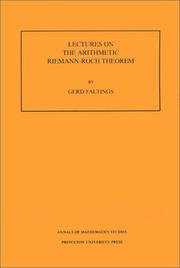
ISBN: 0691087717 0691025444 1400882478 Year: 2016 Volume: vol 127 Publisher: Princeton, NJ : Princeton University Press,
Abstract | Keywords | Export | Availability | Bookmark
 Loading...
Loading...Choose an application
- Reference Manager
- EndNote
- RefWorks (Direct export to RefWorks)
The arithmetic Riemann-Roch Theorem has been shown recently by Bismut-Gillet-Soul. The proof mixes algebra, arithmetic, and analysis. The purpose of this book is to give a concise introduction to the necessary techniques, and to present a simplified and extended version of the proof. It should enable mathematicians with a background in arithmetic algebraic geometry to understand some basic techniques in the rapidly evolving field of Arakelov-theory.
Algebraic geometry --- Algebraïsche meetkunde --- Geometry [Algebraic ] --- Géométrie algébrique --- Meetkunde [Algebraïsche ] --- Riemann-Roch theorema's --- Riemann-Roch thoerems --- Theoremes de Riemann-Roch --- Geometry, Algebraic. --- Riemann-Roch theorems. --- Theorems, Riemann-Roch --- Algebraic functions --- Geometry, Algebraic --- Geometry --- Addition. --- Adjoint. --- Alexander Grothendieck. --- Algebraic geometry. --- Analytic torsion. --- Arakelov theory. --- Asymptote. --- Asymptotic expansion. --- Asymptotic formula. --- Big O notation. --- Cartesian coordinate system. --- Characteristic class. --- Chern class. --- Chow group. --- Closed immersion. --- Codimension. --- Coherent sheaf. --- Cohomology. --- Combination. --- Commutator. --- Computation. --- Covariant derivative. --- Curvature. --- Derivative. --- Determinant. --- Diagonal. --- Differentiable manifold. --- Differential form. --- Dimension (vector space). --- Divisor. --- Domain of a function. --- Dual basis. --- E6 (mathematics). --- Eigenvalues and eigenvectors. --- Embedding. --- Endomorphism. --- Exact sequence. --- Exponential function. --- Generic point. --- Heat kernel. --- Injective function. --- Intersection theory. --- K-group. --- Levi-Civita connection. --- Line bundle. --- Linear algebra. --- Local coordinates. --- Mathematical induction. --- Morphism. --- Natural number. --- Neighbourhood (mathematics). --- Parameter. --- Projective space. --- Pullback (category theory). --- Pullback (differential geometry). --- Pullback. --- Riemannian manifold. --- Riemann–Roch theorem. --- Self-adjoint operator. --- Smoothness. --- Sobolev space. --- Stochastic calculus. --- Summation. --- Supertrace. --- Theorem. --- Transition function. --- Upper half-plane. --- Vector bundle. --- Volume form.
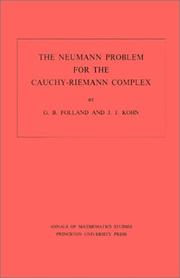
ISBN: 0691081204 1400881528 9780691081205 Year: 1972 Volume: 75 Publisher: Princeton, N.J. Princeton University Press
Abstract | Keywords | Export | Availability | Bookmark
 Loading...
Loading...Choose an application
- Reference Manager
- EndNote
- RefWorks (Direct export to RefWorks)
Part explanation of important recent work, and part introduction to some of the techniques of modern partial differential equations, this monograph is a self-contained exposition of the Neumann problem for the Cauchy-Riemann complex and certain of its applications. The authors prove the main existence and regularity theorems in detail, assuming only a knowledge of the basic theory of differentiable manifolds and operators on Hilbert space. They discuss applications to the theory of several complex variables, examine the associated complex on the boundary, and outline other techniques relevant to these problems. In an appendix they develop the functional analysis of differential operators in terms of Sobolev spaces, to the extent it is required for the monograph.
Functional analysis --- Neumann problem --- Differential operators --- Complex manifolds --- Complex manifolds. --- Differential operators. --- Neumann problem. --- Differential equations, Partial --- Équations aux dérivées partielles --- Analytic spaces --- Manifolds (Mathematics) --- Operators, Differential --- Differential equations --- Operator theory --- Boundary value problems --- A priori estimate. --- Almost complex manifold. --- Analytic function. --- Apply. --- Approximation. --- Bernhard Riemann. --- Boundary value problem. --- Calculation. --- Cauchy–Riemann equations. --- Cohomology. --- Compact space. --- Complex analysis. --- Complex manifold. --- Coordinate system. --- Corollary. --- Derivative. --- Differentiable manifold. --- Differential equation. --- Differential form. --- Differential operator. --- Dimension (vector space). --- Dirichlet boundary condition. --- Eigenvalues and eigenvectors. --- Elliptic operator. --- Equation. --- Estimation. --- Euclidean space. --- Existence theorem. --- Exterior (topology). --- Finite difference. --- Fourier analysis. --- Fourier transform. --- Frobenius theorem (differential topology). --- Functional analysis. --- Hilbert space. --- Hodge theory. --- Holomorphic function. --- Holomorphic vector bundle. --- Irreducible representation. --- Line segment. --- Linear programming. --- Local coordinates. --- Lp space. --- Manifold. --- Monograph. --- Multi-index notation. --- Nonlinear system. --- Operator (physics). --- Overdetermined system. --- Partial differential equation. --- Partition of unity. --- Potential theory. --- Power series. --- Pseudo-differential operator. --- Pseudoconvexity. --- Pseudogroup. --- Pullback. --- Regularity theorem. --- Remainder. --- Scientific notation. --- Several complex variables. --- Sheaf (mathematics). --- Smoothness. --- Sobolev space. --- Special case. --- Statistical significance. --- Sturm–Liouville theory. --- Submanifold. --- Tangent bundle. --- Theorem. --- Uniform norm. --- Vector field. --- Weight function. --- Operators in hilbert space --- Équations aux dérivées partielles
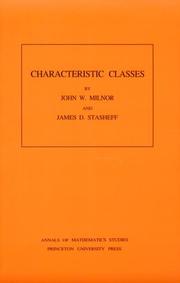
ISBN: 0691081220 9780691081229 140088182X Year: 1974 Volume: 76 Publisher: Princeton, N.J. Princeton University Press
Abstract | Keywords | Export | Availability | Bookmark
 Loading...
Loading...Choose an application
- Reference Manager
- EndNote
- RefWorks (Direct export to RefWorks)
The theory of characteristic classes provides a meeting ground for the various disciplines of differential topology, differential and algebraic geometry, cohomology, and fiber bundle theory. As such, it is a fundamental and an essential tool in the study of differentiable manifolds.In this volume, the authors provide a thorough introduction to characteristic classes, with detailed studies of Stiefel-Whitney classes, Chern classes, Pontrjagin classes, and the Euler class. Three appendices cover the basics of cohomology theory and the differential forms approach to characteristic classes, and provide an account of Bernoulli numbers.Based on lecture notes of John Milnor, which first appeared at Princeton University in 1957 and have been widely studied by graduate students of topology ever since, this published version has been completely revised and corrected.
Algebraic topology --- Characteristic classes --- Classes caractéristiques --- 515.16 --- #WWIS:d.d. Prof. L. Bouckaert/ALTO --- Classes, Characteristic --- Differential topology --- Topology of manifolds --- Characteristic classes. --- 515.16 Topology of manifolds --- Classes caractéristiques --- Additive group. --- Axiom. --- Basis (linear algebra). --- Boundary (topology). --- Bundle map. --- CW complex. --- Canonical map. --- Cap product. --- Cartesian product. --- Characteristic class. --- Charles Ehresmann. --- Chern class. --- Classifying space. --- Coefficient. --- Cohomology ring. --- Cohomology. --- Compact space. --- Complex dimension. --- Complex manifold. --- Complex vector bundle. --- Complexification. --- Computation. --- Conformal geometry. --- Continuous function. --- Coordinate space. --- Cross product. --- De Rham cohomology. --- Diffeomorphism. --- Differentiable manifold. --- Differential form. --- Differential operator. --- Dimension (vector space). --- Dimension. --- Direct sum. --- Directional derivative. --- Eilenberg–Steenrod axioms. --- Embedding. --- Equivalence class. --- Euler class. --- Euler number. --- Existence theorem. --- Existential quantification. --- Exterior (topology). --- Fiber bundle. --- Fundamental class. --- Fundamental group. --- General linear group. --- Grassmannian. --- Gysin sequence. --- Hausdorff space. --- Homeomorphism. --- Homology (mathematics). --- Homotopy. --- Identity element. --- Integer. --- Interior (topology). --- Isomorphism class. --- J-homomorphism. --- K-theory. --- Leibniz integral rule. --- Levi-Civita connection. --- Limit of a sequence. --- Linear map. --- Metric space. --- Natural number. --- Natural topology. --- Neighbourhood (mathematics). --- Normal bundle. --- Open set. --- Orthogonal complement. --- Orthogonal group. --- Orthonormal basis. --- Partition of unity. --- Permutation. --- Polynomial. --- Power series. --- Principal ideal domain. --- Projection (mathematics). --- Representation ring. --- Riemannian manifold. --- Sequence. --- Singular homology. --- Smoothness. --- Special case. --- Steenrod algebra. --- Stiefel–Whitney class. --- Subgroup. --- Subset. --- Symmetric function. --- Tangent bundle. --- Tensor product. --- Theorem. --- Thom space. --- Topological space. --- Topology. --- Unit disk. --- Unit vector. --- Variable (mathematics). --- Vector bundle. --- Vector space. --- Topologie differentielle --- Classes caracteristiques --- Classes et nombres caracteristiques
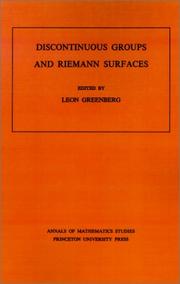
ISBN: 0691081387 1400881641 9780691081380 Year: 1974 Volume: 79 Publisher: Princeton, N.J.
Abstract | Keywords | Export | Availability | Bookmark
 Loading...
Loading...Choose an application
- Reference Manager
- EndNote
- RefWorks (Direct export to RefWorks)
Study 79 contains a collection of papers presented at the Conference on Discontinuous Groups and Ricmann Surfaces at the University of Maryland, May 21-25, 1973. The papers, by leading authorities, deal mainly with Fuchsian and Kleinian groups, Teichmüller spaces, Jacobian varieties, and quasiconformal mappings. These topics are intertwined, representing a common meeting of algebra, geometry, and analysis.
Group theory --- Complex analysis --- Number theory --- RIEMANN SURFACES --- Discontinuous groups --- congresses --- Congresses --- Riemann surfaces --- Congresses. --- Groupes discontinus --- Combinatorial topology --- Functions of complex variables --- Surfaces, Riemann --- Functions --- Abelian variety. --- Adjunction (field theory). --- Affine space. --- Algebraic curve. --- Algebraic structure. --- Analytic function. --- Arithmetic genus. --- Automorphism. --- Bernhard Riemann. --- Boundary (topology). --- Cauchy sequence. --- Cauchy–Schwarz inequality. --- Cayley–Hamilton theorem. --- Closed geodesic. --- Combination. --- Commutative diagram. --- Commutator subgroup. --- Compact Riemann surface. --- Complex dimension. --- Complex manifold. --- Complex multiplication. --- Complex space. --- Complex torus. --- Congruence subgroup. --- Conjugacy class. --- Convex set. --- Cyclic group. --- Degeneracy (mathematics). --- Diagram (category theory). --- Diffeomorphism. --- Differential form. --- Dimension (vector space). --- Disjoint sets. --- E7 (mathematics). --- Endomorphism. --- Equation. --- Equivalence class. --- Euclidean space. --- Existence theorem. --- Existential quantification. --- Finite group. --- Finitely generated group. --- Fuchsian group. --- Fundamental domain. --- Fundamental lemma (Langlands program). --- Fundamental polygon. --- Galois extension. --- Holomorphic function. --- Homeomorphism. --- Homology (mathematics). --- Homomorphism. --- Hurwitz's theorem (number theory). --- Inclusion map. --- Inequality (mathematics). --- Inner automorphism. --- Intersection (set theory). --- Irreducibility (mathematics). --- Isomorphism class. --- Isomorphism theorem. --- Jacobian variety. --- Jordan curve theorem. --- Kleinian group. --- Limit point. --- Mapping class group. --- Metric space. --- Monodromy. --- Monomorphism. --- Möbius transformation. --- Non-Euclidean geometry. --- Orthogonal trajectory. --- Permutation. --- Polynomial. --- Power series. --- Projective variety. --- Quadratic differential. --- Quadric. --- Quasi-projective variety. --- Quasiconformal mapping. --- Quotient space (topology). --- Rectangle. --- Riemann mapping theorem. --- Riemann surface. --- Schwarzian derivative. --- Simply connected space. --- Simultaneous equations. --- Special case. --- Subgroup. --- Subsequence. --- Surjective function. --- Symmetric space. --- Tangent space. --- Teichmüller space. --- Theorem. --- Topological space. --- Topology. --- Uniqueness theorem. --- Unit disk. --- Variable (mathematics). --- Winding number. --- Word problem (mathematics). --- RIEMANN SURFACES - congresses --- Discontinuous groups - Congresses --- Geometrie algebrique --- Fonctions d'une variable complexe --- Surfaces de riemann
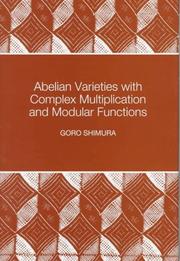
ISBN: 0691016569 1400883946 9780691016566 Year: 1998 Volume: 46 Publisher: Princeton, N.J. Princeton University Press
Abstract | Keywords | Export | Availability | Bookmark
 Loading...
Loading...Choose an application
- Reference Manager
- EndNote
- RefWorks (Direct export to RefWorks)
Reciprocity laws of various kinds play a central role in number theory. In the easiest case, one obtains a transparent formulation by means of roots of unity, which are special values of exponential functions. A similar theory can be developed for special values of elliptic or elliptic modular functions, and is called complex multiplication of such functions. In 1900 Hilbert proposed the generalization of these as the twelfth of his famous problems. In this book, Goro Shimura provides the most comprehensive generalizations of this type by stating several reciprocity laws in terms of abelian varieties, theta functions, and modular functions of several variables, including Siegel modular functions. This subject is closely connected with the zeta function of an abelian variety, which is also covered as a main theme in the book. The third topic explored by Shimura is the various algebraic relations among the periods of abelian integrals. The investigation of such algebraicity is relatively new, but has attracted the interest of increasingly many researchers. Many of the topics discussed in this book have not been covered before. In particular, this is the first book in which the topics of various algebraic relations among the periods of abelian integrals, as well as the special values of theta and Siegel modular functions, are treated extensively.
Ordered algebraic structures --- 512.74 --- Abelian varieties --- Modular functions --- Functions, Modular --- Elliptic functions --- Group theory --- Number theory --- Varieties, Abelian --- Geometry, Algebraic --- Algebraic groups. Abelian varieties --- 512.74 Algebraic groups. Abelian varieties --- Abelian varieties. --- Modular functions. --- Abelian extension. --- Abelian group. --- Abelian variety. --- Absolute value. --- Adele ring. --- Affine space. --- Affine variety. --- Algebraic closure. --- Algebraic equation. --- Algebraic extension. --- Algebraic number field. --- Algebraic structure. --- Algebraic variety. --- Analytic manifold. --- Automorphic function. --- Automorphism. --- Big O notation. --- CM-field. --- Characteristic polynomial. --- Class field theory. --- Coefficient. --- Complete variety. --- Complex conjugate. --- Complex multiplication. --- Complex number. --- Complex torus. --- Corollary. --- Degenerate bilinear form. --- Differential form. --- Direct product. --- Direct proof. --- Discrete valuation ring. --- Divisor. --- Eigenvalues and eigenvectors. --- Embedding. --- Endomorphism. --- Existential quantification. --- Field of fractions. --- Finite field. --- Fractional ideal. --- Function (mathematics). --- Fundamental theorem. --- Galois extension. --- Galois group. --- Galois theory. --- Generic point. --- Ground field. --- Group theory. --- Groupoid. --- Hecke character. --- Homology (mathematics). --- Homomorphism. --- Identity element. --- Integer. --- Irreducibility (mathematics). --- Irreducible representation. --- Lie group. --- Linear combination. --- Linear subspace. --- Local ring. --- Modular form. --- Natural number. --- Number theory. --- Polynomial. --- Prime factor. --- Prime ideal. --- Projective space. --- Projective variety. --- Rational function. --- Rational mapping. --- Rational number. --- Real number. --- Residue field. --- Riemann hypothesis. --- Root of unity. --- Scientific notation. --- Semisimple algebra. --- Simple algebra. --- Singular value. --- Special case. --- Subgroup. --- Subring. --- Subset. --- Summation. --- Theorem. --- Vector space. --- Zero element.
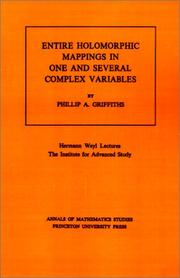
ISBN: 0691081719 0691081727 140088148X 9780691081724 9780691081717 Year: 1976 Volume: no. 85 Publisher: Princeton (N.J.) Princeton university press
Abstract | Keywords | Export | Availability | Bookmark
 Loading...
Loading...Choose an application
- Reference Manager
- EndNote
- RefWorks (Direct export to RefWorks)
The present monograph grew out of the fifth set of Hermann Weyl Lectures, given by Professor Griffiths at the Institute for Advanced Study, Princeton, in fall 1974.In Chapter 1 the author discusses Emile Borel's proof and the classical Jensen theorem, order of growth of entire analytic sets, order functions for entire holomorphic mappings, classical indicators of orders of growth, and entire functions and varieties of finite order.Chapter 2 is devoted to the appearance of curvature, and Chapter 3 considers the defect relations. The author considers the lemma on the logarithmic derivative, R. Nevanlinna's proof of the defect relation, and refinements of the classical case.
Complex analysis --- Holomorphic mappings --- Applications holomorphes --- 517.53 --- Mappings, Holomorphic --- Functions of several complex variables --- Mappings (Mathematics) --- Functions of a complex variable --- Holomorphic mappings. --- 517.53 Functions of a complex variable --- Fonctions de plusieurs variables complexes --- Fonctions entières --- Functions, Entire --- Algebraic variety. --- Analytic function. --- Analytic set. --- Armand Borel. --- Big O notation. --- Canonical bundle. --- Cartesian coordinate system. --- Characteristic function (probability theory). --- Characterization (mathematics). --- Chern class. --- Compact Riemann surface. --- Compact space. --- Complex analysis. --- Complex manifold. --- Complex projective space. --- Corollary. --- Counting. --- Curvature. --- Degeneracy (mathematics). --- Derivative. --- Differential form. --- Dimension. --- Divisor. --- Elementary proof. --- Entire function. --- Equation. --- Exponential growth. --- Gaussian curvature. --- Hermann Weyl. --- Hodge theory. --- Holomorphic function. --- Hyperplane. --- Hypersurface. --- Infinite product. --- Integral geometry. --- Invariant measure. --- Inverse problem. --- Jacobian matrix and determinant. --- Kähler manifold. --- Line bundle. --- Linear equation. --- Logarithmic derivative. --- Manifold. --- Meromorphic function. --- Modular form. --- Monograph. --- Nevanlinna theory. --- Nonlinear system. --- Phillip Griffiths. --- Picard theorem. --- Polynomial. --- Projective space. --- Q.E.D. --- Quantity. --- Ricci curvature. --- Riemann sphere. --- Scientific notation. --- Several complex variables. --- Special case. --- Stokes' theorem. --- Subset. --- Summation. --- Theorem. --- Theory. --- Uniformization theorem. --- Unit square. --- Volume form. --- Fonctions entières
Book
ISBN: 069108176X 1322884951 1400869307 0691636443 Year: 1978 Publisher: Princeton, N.J.
Abstract | Keywords | Export | Availability | Bookmark
 Loading...
Loading...Choose an application
- Reference Manager
- EndNote
- RefWorks (Direct export to RefWorks)
The classical uniformization theorem for Riemann surfaces and its recent extensions can be viewed as introducing special pseudogroup structures, affine or projective structures, on Riemann surfaces. In fact, the additional structures involved can be considered as local forms of the uniformizations of Riemann surfaces. In this study, Robert Gunning discusses the corresponding pseudogroup structures on higher-dimensional complex manifolds, modeled on the theory as developed for Riemann surfaces.Originally published in 1978.The Princeton Legacy Library uses the latest print-on-demand technology to again make available previously out-of-print books from the distinguished backlist of Princeton University Press. These editions preserve the original texts of these important books while presenting them in durable paperback and hardcover editions. The goal of the Princeton Legacy Library is to vastly increase access to the rich scholarly heritage found in the thousands of books published by Princeton University Press since its founding in 1905.
Analytical spaces --- Differential geometry. Global analysis --- Complex manifolds --- Connections (Mathematics) --- Pseudogroups --- Mathematics --- Physical Sciences & Mathematics --- Calculus --- Global analysis (Mathematics) --- Lie groups --- Geometry, Differential --- Analytic spaces --- Manifolds (Mathematics) --- Adjunction formula. --- Affine connection. --- Affine transformation. --- Algebraic surface. --- Algebraic torus. --- Algebraic variety. --- Analytic continuation. --- Analytic function. --- Automorphic function. --- Automorphism. --- Bilinear form. --- Canonical bundle. --- Characterization (mathematics). --- Cohomology. --- Compact Riemann surface. --- Complex Lie group. --- Complex analysis. --- Complex dimension. --- Complex manifold. --- Complex multiplication. --- Complex number. --- Complex plane. --- Complex torus. --- Complex vector bundle. --- Contraction mapping. --- Covariant derivative. --- Differentiable function. --- Differentiable manifold. --- Differential equation. --- Differential form. --- Differential geometry. --- Differential operator. --- Dimension (vector space). --- Dimension. --- Elliptic operator. --- Elliptic surface. --- Enriques surface. --- Equation. --- Existential quantification. --- Explicit formula. --- Explicit formulae (L-function). --- Exterior derivative. --- Fiber bundle. --- General linear group. --- Geometric genus. --- Group homomorphism. --- Hausdorff space. --- Holomorphic function. --- Homomorphism. --- Identity matrix. --- Invariant subspace. --- Invertible matrix. --- Irreducible representation. --- Jacobian matrix and determinant. --- K3 surface. --- Kähler manifold. --- Lie algebra representation. --- Lie algebra. --- Line bundle. --- Linear equation. --- Linear map. --- Linear space (geometry). --- Linear subspace. --- Manifold. --- Mathematical analysis. --- Mathematical induction. --- Ordinary differential equation. --- Partial differential equation. --- Permutation. --- Polynomial. --- Principal bundle. --- Projection (linear algebra). --- Projective connection. --- Projective line. --- Pseudogroup. --- Quadratic transformation. --- Quotient space (topology). --- Representation theory. --- Riemann surface. --- Riemann–Roch theorem. --- Schwarzian derivative. --- Sheaf (mathematics). --- Special case. --- Subalgebra. --- Subgroup. --- Submanifold. --- Symmetric tensor. --- Symmetrization. --- Tangent bundle. --- Tangent space. --- Tensor field. --- Tensor product. --- Tensor. --- Theorem. --- Topological manifold. --- Uniformization theorem. --- Uniformization. --- Unit (ring theory). --- Vector bundle. --- Vector space. --- Fonctions de plusieurs variables complexes --- Variétés complexes
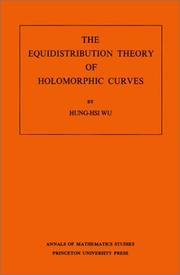
ISBN: 0691080739 1400881900 Year: 1970 Publisher: Tokyo : University of Tokyo press,
Abstract | Keywords | Export | Availability | Bookmark
 Loading...
Loading...Choose an application
- Reference Manager
- EndNote
- RefWorks (Direct export to RefWorks)
This work is a fresh presentation of the Ahlfors-Weyl theory of holomorphic curves that takes into account some recent developments in Nevanlinna theory and several complex variables. The treatment is differential geometric throughout, and assumes no previous acquaintance with the classical theory of Nevanlinna. The main emphasis is on holomorphic curves defined over Riemann surfaces, which admit a harmonic exhaustion, and the main theorems of the subject are proved for such surfaces. The author discusses several directions for further research.
Analytic functions. --- Functions, Meromorphic. --- Value distribution theory. --- Meromorphic functions --- Functions, Analytic --- Functions, Monogenic --- Functions, Regular --- Regular functions --- Functions of complex variables --- Series, Taylor's --- Distribution of values theory --- Functions, Entire --- Functions, Meromorphic --- Addition. --- Algebraic curve. --- Algebraic number. --- Atlas (topology). --- Binomial coefficient. --- Cauchy–Riemann equations. --- Compact Riemann surface. --- Compact space. --- Complex manifold. --- Complex projective space. --- Computation. --- Continuous function (set theory). --- Covariant derivative. --- Critical value. --- Curvature form. --- Diagram (category theory). --- Differential form. --- Differential geometry of surfaces. --- Differential geometry. --- Dimension. --- Divisor. --- Essential singularity. --- Euler characteristic. --- Existential quantification. --- Fiber bundle. --- Gaussian curvature. --- Geodesic curvature. --- Geometry. --- Grassmannian. --- Harmonic function. --- Hermann Weyl. --- Hermitian manifold. --- Holomorphic function. --- Homology (mathematics). --- Hyperbolic manifold. --- Hyperplane. --- Hypersurface. --- Improper integral. --- Intersection number (graph theory). --- Isometry. --- Line integral. --- Manifold. --- Meromorphic function. --- Minimal surface. --- Nevanlinna theory. --- One-form. --- Open problem. --- Open set. --- Orthogonal complement. --- Parameter. --- Picard theorem. --- Product metric. --- Q.E.D. --- Remainder. --- Riemann sphere. --- Riemann surface. --- Smoothness. --- Special case. --- Submanifold. --- Subset. --- Tangent space. --- Tangent. --- Theorem. --- Three-dimensional space (mathematics). --- Unit circle. --- Unit vector. --- Vector field. --- Volume element. --- Volume form. --- Fonctions de plusieurs variables complexes
Book
ISBN: 0691138214 1400837111 0691138222 9780691138220 9781400837113 9780691138213 Year: 2008 Publisher: Princeton, NJ
Abstract | Keywords | Export | Availability | Bookmark
 Loading...
Loading...Choose an application
- Reference Manager
- EndNote
- RefWorks (Direct export to RefWorks)
In 1970, Phillip Griffiths envisioned that points at infinity could be added to the classifying space D of polarized Hodge structures. In this book, Kazuya Kato and Sampei Usui realize this dream by creating a logarithmic Hodge theory. They use the logarithmic structures begun by Fontaine-Illusie to revive nilpotent orbits as a logarithmic Hodge structure. The book focuses on two principal topics. First, Kato and Usui construct the fine moduli space of polarized logarithmic Hodge structures with additional structures. Even for a Hermitian symmetric domain D, the present theory is a refinement of the toroidal compactifications by Mumford et al. For general D, fine moduli spaces may have slits caused by Griffiths transversality at the boundary and be no longer locally compact. Second, Kato and Usui construct eight enlargements of D and describe their relations by a fundamental diagram, where four of these enlargements live in the Hodge theoretic area and the other four live in the algebra-group theoretic area. These two areas are connected by a continuous map given by the SL(2)-orbit theorem of Cattani-Kaplan-Schmid. This diagram is used for the construction in the first topic.
Hodge theory. --- Logarithms. --- Logs (Logarithms) --- Algebra --- Complex manifolds --- Differentiable manifolds --- Geometry, Algebraic --- Homology theory --- Algebraic group. --- Algebraic variety. --- Analytic manifold. --- Analytic space. --- Annulus (mathematics). --- Arithmetic group. --- Atlas (topology). --- Canonical map. --- Classifying space. --- Coefficient. --- Cohomology. --- Compactification (mathematics). --- Complex manifold. --- Complex number. --- Congruence subgroup. --- Conjecture. --- Connected component (graph theory). --- Continuous function. --- Convex cone. --- Degeneracy (mathematics). --- Diagram (category theory). --- Differential form. --- Direct image functor. --- Divisor. --- Elliptic curve. --- Equivalence class. --- Existential quantification. --- Finite set. --- Functor. --- Geometry. --- Hodge structure. --- Homeomorphism. --- Homomorphism. --- Inverse function. --- Iwasawa decomposition. --- Local homeomorphism. --- Local ring. --- Local system. --- Logarithmic. --- Maximal compact subgroup. --- Modular curve. --- Modular form. --- Moduli space. --- Monodromy. --- Monoid. --- Morphism. --- Natural number. --- Nilpotent orbit. --- Nilpotent. --- Open problem. --- Open set. --- P-adic Hodge theory. --- P-adic number. --- Point at infinity. --- Proper morphism. --- Pullback (category theory). --- Quotient space (topology). --- Rational number. --- Relative interior. --- Ring (mathematics). --- Ring homomorphism. --- Scientific notation. --- Set (mathematics). --- Sheaf (mathematics). --- Smooth morphism. --- Special case. --- Strong topology. --- Subgroup. --- Subobject. --- Subset. --- Surjective function. --- Tangent bundle. --- Taylor series. --- Theorem. --- Topological space. --- Topology. --- Transversality (mathematics). --- Two-dimensional space. --- Vector bundle. --- Vector space. --- Weak topology.
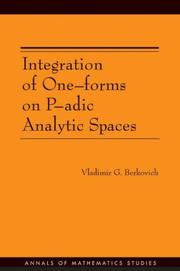
ISBN: 0691128626 1299133339 1400837154 0691127417 9781400837151 9780691127415 9780691128627 9781299133334 Year: 2006 Volume: no. 162 Publisher: Princeton, NJ
Abstract | Keywords | Export | Availability | Bookmark
 Loading...
Loading...Choose an application
- Reference Manager
- EndNote
- RefWorks (Direct export to RefWorks)
Among the many differences between classical and p-adic objects, those related to differential equations occupy a special place. For example, a closed p-adic analytic one-form defined on a simply-connected domain does not necessarily have a primitive in the class of analytic functions. In the early 1980s, Robert Coleman discovered a way to construct primitives of analytic one-forms on certain smooth p-adic analytic curves in a bigger class of functions. Since then, there have been several attempts to generalize his ideas to smooth p-adic analytic spaces of higher dimension, but the spaces considered were invariably associated with algebraic varieties. This book aims to show that every smooth p-adic analytic space is provided with a sheaf of functions that includes all analytic ones and satisfies a uniqueness property. It also contains local primitives of all closed one-forms with coefficients in the sheaf that, in the case considered by Coleman, coincide with those he constructed. In consequence, one constructs a parallel transport of local solutions of a unipotent differential equation and an integral of a closed one-form along a path so that both depend nontrivially on the homotopy class of the path. Both the author's previous results on geometric properties of smooth p-adic analytic spaces and the theory of isocrystals are further developed in this book, which is aimed at graduate students and mathematicians working in the areas of non-Archimedean analytic geometry, number theory, and algebraic geometry.
p-adic analysis. --- Analysis, p-adic --- Algebra --- Calculus --- Geometry, Algebraic --- Abelian category. --- Acting in. --- Addition. --- Aisle. --- Algebraic closure. --- Algebraic curve. --- Algebraic structure. --- Algebraic variety. --- Allegory (category theory). --- Analytic function. --- Analytic geometry. --- Analytic space. --- Archimedean property. --- Arithmetic. --- Banach algebra. --- Bertolt Brecht. --- Buttress. --- Centrality. --- Clerestory. --- Commutative diagram. --- Commutative property. --- Complex analysis. --- Contradiction. --- Corollary. --- Cosmetics. --- De Rham cohomology. --- Determinant. --- Diameter. --- Differential form. --- Dimension (vector space). --- Divisor. --- Elaboration. --- Embellishment. --- Equanimity. --- Equivalence class (music). --- Existential quantification. --- Facet (geometry). --- Femininity. --- Finite morphism. --- Formal scheme. --- Fred Astaire. --- Functor. --- Gavel. --- Generic point. --- Geometry. --- Gothic architecture. --- Homomorphism. --- Hypothesis. --- Imagery. --- Injective function. --- Irreducible component. --- Iterated integral. --- Linear combination. --- Logarithm. --- Marni Nixon. --- Masculinity. --- Mathematical induction. --- Mathematics. --- Mestizo. --- Metaphor. --- Morphism. --- Natural number. --- Neighbourhood (mathematics). --- Neuroticism. --- Noetherian. --- Notation. --- One-form. --- Open set. --- P-adic Hodge theory. --- P-adic number. --- Parallel transport. --- Patrick Swayze. --- Phrenology. --- Politics. --- Polynomial. --- Prediction. --- Proportion (architecture). --- Pullback. --- Purely inseparable extension. --- Reims. --- Requirement. --- Residue field. --- Rhomboid. --- Roland Barthes. --- Satire. --- Self-sufficiency. --- Separable extension. --- Sheaf (mathematics). --- Shuffle algebra. --- Subgroup. --- Suggestion. --- Technology. --- Tensor product. --- Theorem. --- Transept. --- Triforium. --- Tubular neighborhood. --- Underpinning. --- Writing. --- Zariski topology.
| Listing 1 - 10 of 22 | << page >> |
Sort by
|

 Search
Search Feedback
Feedback About UniCat
About UniCat  Help
Help News
News